Reconstruction of Annual Glacier Mass Balance from Remote Sensing-Derived Average Glacier-Wide Albedo
Abstract
1. Introduction
2. Chhota Shigri Glacier
3. Data and Methodology
3.1. Datasets Used in This Study
3.1.1. MODImLab Products and Glacier-Wide Albedo
3.1.2. Landsat Imagery
3.1.3. Field Measurements
3.1.4. Glacier Outlines
3.2. The Improved Albedo–Mass Balance (IAMB) Method
3.3. Estimation of the Mass Balance–Albedo Gradient
- Estimation of the glacier albedo. Cloud-free Landsat imageries were utilized to calculate the broadband glacier albedo with the method proposed by Knap et al. (1999) [45]. Data pre-processing, including calibration, Fast Line-of-sight Atmospheric Analysis of Spectral Hypercubes (FLAASH) atmospheric correction, topographic correction [46] and spatial clipping, were undertaken prior to the albedo estimation;
- Extraction of the DEM and albedo data. We used the C-band Shuttle Radar Topography Mission (SRTM) digital elevation model (DEM) with approximately 30 m spatial resolution to acquire the glacier elevation information. Co-registration of the glacier DEM and Landsat imagery was completed to ensure the spatial consistency and extract the corresponding glacier elevation and albedo for each pixel;
- Calculation of . Assuming that the glacier elevation ranges from (the lowest elevation) to (the highest elevation), the glacier can be divided into () 10 m altitude intervals. The average glacier albedo () for altitude band was calculated, providing a curve representing the variation in albedo with altitude, from which could be obtained.
3.4. Uncertainty Analysis
- The uncertainty in associated with is related to the glacier mass balance data used in the study. If is averaged from the observed mass balance, is determined with in situ data from each year. If is obtained from the geodetic mass balance over several years, then depends on the uncertainties associated with each glacier DEM, the geo-referencing and co-registration errors of the DEMs and the glacier density used to convert the change in elevation into the mass balance [47]. In this study, was calculated from field annual mass balance series, and the uncertainty range for the measured data was fixed at ±0.40 m w.e. [29]. Therefore, the uncertainty in was also a constant number over the studied period;
- The uncertainty in can be computed using the error propagation approach [48], considering the uncertainty in each term of and . Given that is different from year to year and glacier to glacier, we used a variability of ±0.09 m w.e. (100 m)−1 as an estimate of uncertainty [29]. The uncertainty in results from (1) the glacier albedo retrieval from optical imagery, (2) the image registration of Landsat and SRTM DEM data and (3) the accuracy of the DEM. Combining these different sources of error, we estimated that the uncertainty of was equal to the standard deviation, which was 12.69 m/(0.01 albedo) for the Chhota Shigri glacier (see Table 2 in Section 4.2);
- The uncertainty in the glacier summer albedo anomaly is not only affected by the summer albedo in year i but also those of all years. Based on the glacier-wide average albedo error referred to in Section 3.2, the uncertainty in can be estimated with the following expression:
4. Results
4.1. The Averaged Glacier-Wide Albedo
4.2. Mass Balance–Albedo Gradient
4.3. Reconstructed Annual Mass Balance Series
5. Discussion
5.1. Sensitivity of the IAMB Mass Balance to
5.2. Sensitivity of Estimated Mass Balance to
5.3. Effect of Elevation on The
5.4. Why Not Choose the Minimum Albedo?
5.5. The IAMB Method: Future Prospects and Limitations
6. Conclusions
Author Contributions
Funding
Data Availability Statement
Acknowledgments
Conflicts of Interest
References
- Yao, T.; Thompson, L.; Yang, W.; Yu, W.; Gao, Y.; Guo, X.; Yang, X.; Duan, K.; Zhao, H.; Xu, B.; et al. Different glacier status with atmospheric circulations in Tibetan Plateau and surroundings. Nat. Clim. Change 2012, 2, 663–667. [Google Scholar] [CrossRef]
- Roe, G.; Baker, M.; Herla, F. Centennial glacier retreat as categorical evidence of regional climate change. Nat. Geosci. 2017, 10, 95–99. [Google Scholar] [CrossRef]
- Marzeion, B.; Jarosch, A.H.; Gregory, J.M. Feedbacks and mechanisms affecting the global sensitivity of glaciers to climate change. Cryosphere 2014, 8, 59–71. [Google Scholar] [CrossRef]
- Vuille, M.; Carey, M.; Huggel, C.; Buytaert, W.; Rabatel, A.; Jacobsen, D.; Soruco, A.; Villacis, M.; Yarleque, C.; Timm, O.E.; et al. Rapid decline of snow and ice in the tropical Andes–Impacts, uncertainties and challenges ahead. Earth Sci. Rev. 2018, 176, 195–213. [Google Scholar] [CrossRef]
- Constable, A.J.; Harper, S.; Dawson, J.; Holsman, K.; Mustonen, T.; Piepenburg, D.; Rost, B. Cross-Chapter Paper 6: Polar Regions. In Climate Change 2022: Impacts, Adaptation and Vulnerability; Contribution of Working Group II to the Sixth Assessment Report of the Intergovernmental Panel on Climate Change; IPCC: Geneva, Switzerland, 2022. [Google Scholar]
- The IMBIE Team. Mass balance of the Greenland Ice Sheet from 1992 to 2018. Nature 2020, 579, 233–239. [Google Scholar] [CrossRef]
- Roe, G.H.; Christian, J.E.; Marzeion, B. On the attribution of industrial-era glacier mass loss to anthropogenic climate change. Cryosphere 2021, 15, 1889–1905. [Google Scholar] [CrossRef]
- Shugar, D.H.; Jacquemart, M.; Shean, D.; Bhushan, S.; Upadhyay, K.; Sattar, A.; Schwanghart, W.; McBride, S.; de Vries, M.V.W.; Mergili, M.; et al. A massive rock and ice avalanche caused the 2021 disaster at Chamoli, Indian Himalaya. Science 2021, 373, 300–306. [Google Scholar] [CrossRef]
- Xue, Y.; Jing, Z.; Kang, S.; He, X.; Li, C. Combining UAV and Landsat data to assess glacier changes on the central Tibetan Plateau. J. Glaciol. 2021, 67, 862–874. [Google Scholar] [CrossRef]
- Liu, L.; Menenti, M.; Ma, Y. Evaluation of Albedo Schemes in WRF Coupled with Noah-MP on the Parlung No. 4 Glacier. Remote Sens. 2022, 14, 3934. [Google Scholar] [CrossRef]
- Xiao, Y.; Ke, C.Q.; Fan, Y.; Shen, X.; Cai, Y. Estimating glacier mass balance in High Mountain Asia based on Moderate Resolution Imaging Spectroradiometer retrieved surface albedo from 2000 to 2020. Int. J. Climatol. 2022. [Google Scholar] [CrossRef]
- Brock, B.W.; Willis, I.C.; Sharp, M.J. Measurement and parameterization of albedo variations at Haut Glacier d’Arolla, Switzerland. J. Glaciol. 2000, 46, 675–688. [Google Scholar] [CrossRef]
- Ming, J.; Wang, Y.; Du, Z.; Zhang, T.; Guo, W.; Xiao, C.; Xu, X.; Ding, M.; Zhang, D.; Yang, W. Widespread Albedo Decreasing and Induced Melting of Himalayan Snow and Ice in the Early 21st Century. PLoS ONE 2015, 10, e0126235. [Google Scholar] [CrossRef] [PubMed]
- Barandun, M.; Bravo, C.; Grobety, B.; Jenk, T.; Fang, L.; Naegeli, K.; Rivera, A.; Cisternas, S.; Münster, T.; Schwikowski, M. Anthropogenic influence on surface changes at the Olivares glaciers; Central Chile. Sci. Total Environ. 2022, 833, 155068. [Google Scholar] [CrossRef] [PubMed]
- Dyurgerov, M.; Meier, M.F.; Bahr, D.B. A new index of glacier area change: A tool for glacier monitoring. J. Glaciol. 2009, 55, 710–716. [Google Scholar] [CrossRef]
- Rabatel, A.; Dedieu, J.P.; Vincent, C. Using remote-sensing data to determine equilibrium-line altitude and mass-balance time series: Validation on three french glaciers, 1994–2002. J. Glaciol. 2005, 51, 539–546. [Google Scholar] [CrossRef]
- Rabatel, A.; Dedieu, J.P.; Vincent, C. Spatio-temporal changes in glacier-wide mass balance quantified by optical remote sensing on 30 glaciers in the French Alps for the period 1983–2014. J. Glaciol. 2016, 62, 1153–1166. [Google Scholar] [CrossRef]
- Dumont, M.; Gardelle, J.; Sirguey, P.; Guillot, A.; Six, D.; Rabatel, A.; Arnaud, Y. Linking glacier annual mass balance and glacier albedo retrieved from MODIS data. Cryosphere 2012, 6, 1527–1539. [Google Scholar] [CrossRef]
- Brun, F.; Dumont, M.; Wagnon, P.; Berthier, E.; Azam, M.F.; Shea, J.M.; Sirguey, P.; Rabatel, A.; Ramanathan, A. Seasonal changes in surface albedo of himalayan glaciers from MODIS data and links with the annual mass balance. Cryosphere 2015, 9, 341–355. [Google Scholar] [CrossRef]
- Sirguey, P.; Still, H.; Cullen, N.J.; Dumont, M.; Arnaud, Y.; Conway, J.P. Reconstructing the mass balance of brewster glacier, new zealand, using modis-derived glacier-wide albedo. Cryosphere 2016, 10, 2465–2484. [Google Scholar] [CrossRef]
- Davaze, L.; Rabatel, A.; Arnaud, Y.; Sirguey, P.; Six, D.; Letreguilly, A.; Dumont, M. Monitoring glacier albedo as a proxy to derive summer and annual surface mass balances from optical remote-sensing data. Cryosphere 2018, 12, 271–286. [Google Scholar] [CrossRef]
- Zhang, Z.; Jiang, L.; Liu, L.; Sun, Y.; Wang, H. Annual Glacier-Wide Mass Balance (2000–2016) of the Interior Tibetan Plateau Reconstructed from MODIS Albedo Products. Remote Sens. 2018, 10, 1031. [Google Scholar] [CrossRef]
- De Wildt, M.S.D.R.; Oerlemans, J.; Björnsson, H. A method for monitoring glacier mass balance using satellite albedo measurements: Application to Vatnajökull, Iceland. J. Glaciol. 2002, 48, 267–278. [Google Scholar] [CrossRef]
- Greuell, W.; Kohler, J.; Obleitner, F.; Glowacki, P.; Melvold, K.; Bernsen, E.; Oerlemans, J. Assessment of interannual variations in the surface mass balance of 18 Svalbard glaciers from the Moderate Resolution Imaging Spectroradiometer/Terra albedo product. J. Geophys. Res. Atmos. 2007, 112. [Google Scholar] [CrossRef]
- Greuell, W.; Oerlemans, J. Narrowband-to-broadband albedo conversion for glacier ice and snow: Equations based on modeling and ranges of validity of the equations. Remote Sens. Environ. 2004, 89, 95–105. [Google Scholar] [CrossRef]
- Colgan, W.; Box, J.E.; Fausto, R.S.; Van As, D.; Barletta, V.R.; Forsberg, R. Surface albedo as a proxy for the mass balance of Greenland’s terrestrial ice. GEUS Bull. 2014, 31, 91–94. [Google Scholar] [CrossRef][Green Version]
- Williamson, S.N.; Copland, L.; Thomson, L.; Burgess, D. Comparing simple albedo scaling methods for estimating Arctic glacier mass balance. Remote Sens. Environ. 2020, 246, 111858. [Google Scholar] [CrossRef]
- Sirguey, P.; Mathieu, R.; Arnaud, Y. Subpixel monitoring of the seasonal snow cover with MODIS at 250 m spatial resolution in the Southern Alps of New Zealand: Methodology and accuracy assessment. Remote Sens. Environ. 2009, 113, 160–181. [Google Scholar] [CrossRef]
- Azam, M.F.; Ramanathan, A.L.; Wagnon, P.; Vincent, C.; Linda, A.; Berthier, E.; Sharma, P.; Mandal, A.; Angchuk, T.; Singh, V.B.; et al. Meteorological conditions, seasonal and annual mass balances of Chhota Shigri Glacier, western Himalaya, India. Ann. Glaciol. 2016, 57, 328–338. [Google Scholar] [CrossRef]
- Azam, M.F.; Wagnon, P.; Vincent, C.; Ramanathan, A.; Linda, A.; Singh, V.B. Reconstruction of the annual mass balance of Chhota Shigri glacier, Western Himalaya, India, since 1969. Ann. Glaciol. 2014, 55, 69–80. [Google Scholar] [CrossRef]
- Wagnon, P.; Linda, A.; Arnaud, Y.; Kumar, R.; Sharma, P.; Vincent, C.; Pottakkal, J.G.; Berthier, E.; Ramanathan, A.; Hasnain, S.I.; et al. Four years of mass balance on Chhota Shigri Glacier, Himachal Pradesh, India, a new benchmark glacier in the western Himalaya. J. Glaciol. 2007, 53, 603–611. [Google Scholar] [CrossRef]
- Garg, P.K.; Shukla, A.; Tiwari, R.K.; Jasrotia, A.S. Assessing the status of glaciers in part of the Chandra basin, Himachal Himalaya: A multiparametric approach. Geomorphology 2017, 284, 99–114. [Google Scholar] [CrossRef]
- Azam, M.F.; Wagnon, P.; Vincent, C.; Ramanathan, A.L.; Favier, V.; Mandal, A.; Pottakkal, J.G. Processes governing the mass balance of Chhota Shigri Glacier (western Himalaya, India) assessed by point-scale surface energy balance measurements. Cryosphere 2014, 8, 2195–2217. [Google Scholar] [CrossRef]
- Ramanathan, A. Status report on Chhota Shigri Glacier (Himachal Pradesh), Department of science and technology, ministry of science and technology, New Delhi. Himal. Glaciol. Tech. Rep. 2011, 1, 88. [Google Scholar]
- Sirguey, P. Simple correction of multiple reflection effects in rugged terrain. Int. J. Remote Sens. 2009, 30, 1075–1081. [Google Scholar] [CrossRef]
- Dumont, M.; Sirguey, P.; Arnaud, Y.; Six, D. Monitoring spatial and temporal variations of surface albedo on Saint Sorlin Glacier (French Alps) using terrestrial photography. Cryosphere 2011, 5, 759–771. [Google Scholar] [CrossRef]
- Traversa, G.; Fugazza, D.; Senese, A.; Frezzotti, M. Landsat 8 OLI broadband albedo validation in Antarctica and Greenland. Remote Sens. 2021, 13, 799. [Google Scholar] [CrossRef]
- Mandal, A.; Ramanathan, A.; Azam, M.F.; Angchuk, T.; Soheb, M.; Kumar, N.; Pottakkal, J.G.; Vatsal, S.; Mishra, S.; Singh, V.B. Understanding the interrelationships among mass balance, meteorology, discharge and surface velocity on Chhota Shigri Glacier over 2002–2019 using in situ measurements. J. Glaciol. 2020, 66, 727–741. [Google Scholar] [CrossRef]
- Naegeli, K.; Huss, M. Sensitivity of mountain glacier mass balance to changes in bare-ice albedo. Ann. Glaciol. 2017, 58, 119–129. [Google Scholar] [CrossRef]
- Rabatel, A.; Sirguey, P.; Drolon, V.; Maisongrande, P.; Arnaud, Y.; Berthier, E.; Davaze, L.; Dedieu, J.; Dumont, M. Annual and Seasonal Glacier-Wide Surface Mass Balance Quantified from Changes in Glacier Surface State: A Review on Existing Methods Using Optical Satellite Imagery. Remote Sens. 2017, 9, 507. [Google Scholar] [CrossRef]
- Berthier, E.; Arnaud, Y.; Baratoux, D.; Vincent, C.; Rémy, F. Recent rapid thinning of the “Mer de Glace” glacier derived from satellite optical images. Geophys. Res. Lett. 2004, 31, L17401. [Google Scholar] [CrossRef]
- Tseng, K.H.; Chang, C.P.; Shum, C.K.; Kuo, C.Y.; Liu, K.T.; Shang, K.; Jia, Y.; Sun, J. Quantifying Freshwater Mass Balance in the Central Tibetan Plateau by Integrating Satellite Remote Sensing, Altimetry, and Gravimetry. Remote Sens. 2016, 8, 441. [Google Scholar] [CrossRef]
- Lu, Y.; Zhang, Z.; Kong, Y.; Hu, K. Integration of optical, SAR and DEM data for automated detection of debris-covered glaciers over the western Nyainqentanglha using a random forest classifier. Cold Reg. Sci. Technol. 2022, 193, 103421. [Google Scholar] [CrossRef]
- Wang, X.; Voytenko, D.; Holland, D.M. Accuracy evaluation of digital elevation models derived from Terrestrial Radar Interferometer over Helheim Glacier, Greenland. Remote Sens. Environ. 2022, 268, 112759. [Google Scholar] [CrossRef]
- Knap, W.H.; Reijmer, C.H.; Oerlemans, J. Narrowband to broadband conversion of Landsat TM glacier albedos. Int. J. Remote Sens. 1999, 20, 2091–2110. [Google Scholar] [CrossRef]
- Yue, X.Y.; Zhao, J.; Li, Z.Q.; Zhang, M.J.; Fan, J.; Wang, L.; Wang, P.Y. Spatial and temporal variations of the surface albedo and other factors influencing Urumqi Glacier No. 1 in Tien Shan, China. J. Glaciol. 2017, 63, 899–911. [Google Scholar] [CrossRef]
- Neckel, N.; Braun, A.; Kropácek, J.; Hochschild, V. Recent mass balance of the Purogangri Ice Cap, central Tibetan Plateau, by means of differential X-band SAR interferometry. Cryosphere 2013, 7, 1623–1633. [Google Scholar] [CrossRef]
- Wang, H.; Jia, L.; Steffen, H.; Wu, P.; Jiang, L.; Hsu, H.; Xiang, L.; Wang, Z.; Hu, B. Increased water storage in north america and scandinavia from grace gravity data. Nat. Geosci. 2012, 6, 38–42. [Google Scholar] [CrossRef]
- Wang, Q.; Yi, S.; Sun, W. Continuous Estimates of Glacier Mass Balance in High Mountain Asia Based on ICESat-1,2 and GRACE/GRACE Follow-On Data. Geophys. Res. Lett. 2021, 48, e2020GL090954. [Google Scholar] [CrossRef]
- Gardelle, J.; Berthier, E.; Arnaud, Y.; Kääb, A. Region-wide glacier mass balances over the Pamir-Karakoram-Himalaya during 1999-2011. Cryosphere 2013, 7, 1263–1286. [Google Scholar] [CrossRef]
- Bolch, T.; Pieczonka, T.; Mukherjee, K.; Shea, J. Brief communication: Glaciers in the Hunza catchment (Karakoram) have been nearly in balance since the 1970s. Cryosphere 2017, 11, 531–539. [Google Scholar] [CrossRef]
- Ren, S.; Li, X.; Wang, Y.; Zheng, D.; Jiang, D.; Nian, Y.; Zhou, Y. Multitemporal Glacier Mass Balance and Area Changes in the Puruogangri Ice Field during 1975–2021 Based on Multisource Satellite Observations. Remote Sens. 2022, 14, 4078. [Google Scholar] [CrossRef]
- Zhou, L.; Divakarla, M.; Liu, X.; Layns, A.; Goldberg, M. An overview of the science performances and calibration/validation of joint polar satellite system operational products. Remote Sens. 2019, 11, 698. [Google Scholar] [CrossRef]
- Wehrlé, A.; Box, J.E.; Niwano, M.; Anesio, A.M.; Fausto, R.S. Greenland bare-ice albedo from PROMICE automatic weather station measurements and Sentinel-3 satellite observations. GEUS Bull. 2021, 47, 5284. [Google Scholar] [CrossRef]
- Chandrasekharan, A.; Ramsankaran, R.A.A.J.; Pandit, A.; Rabatel, A. Quantification of annual glacier surface mass balance for the Chhota Shigri Glacier, Western Himalayas, India using an Equilibrium-Line Altitude (ELA) based approach. Int. J. Remote Sens. 2018, 39, 9092–9112. [Google Scholar] [CrossRef]
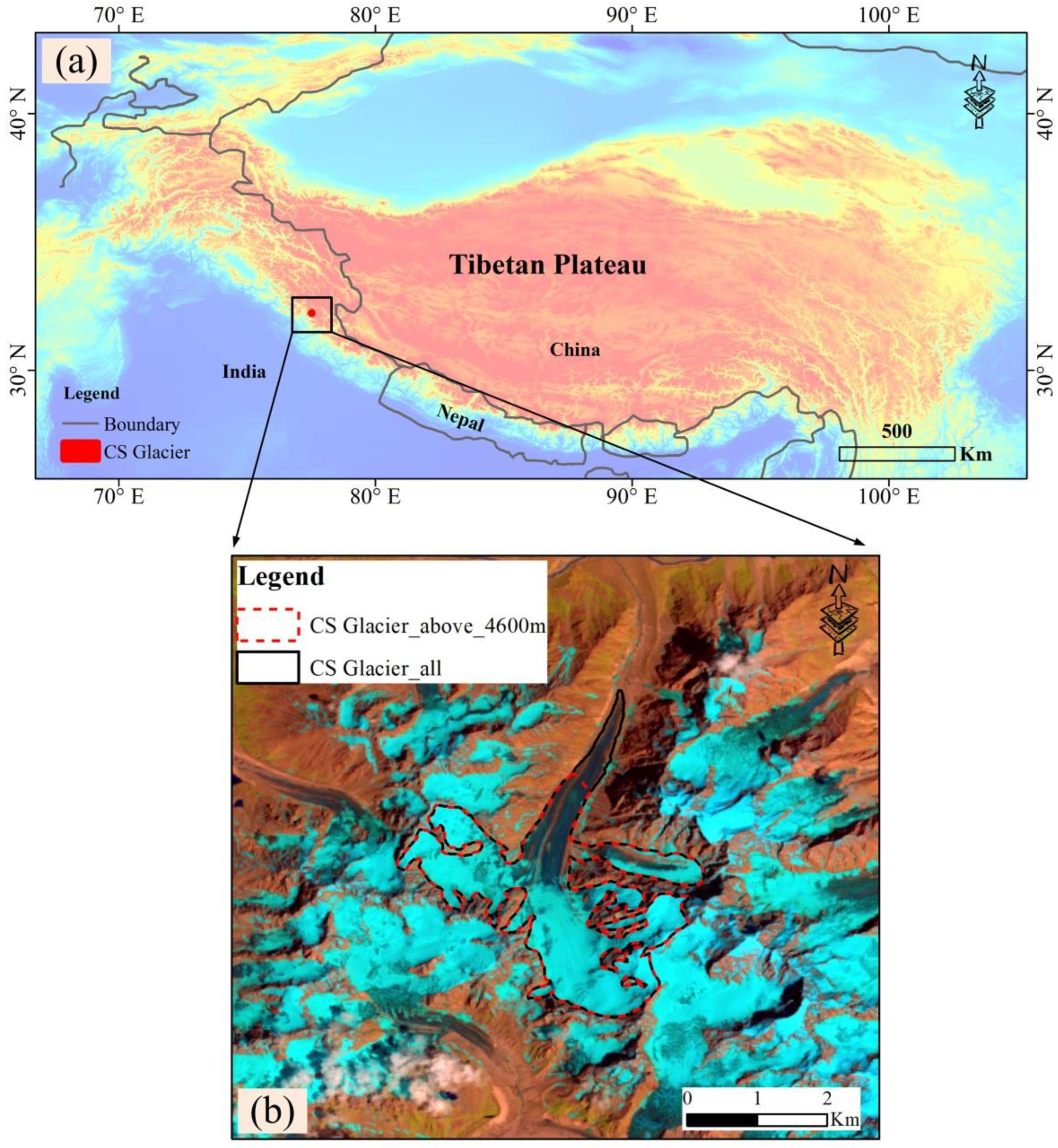
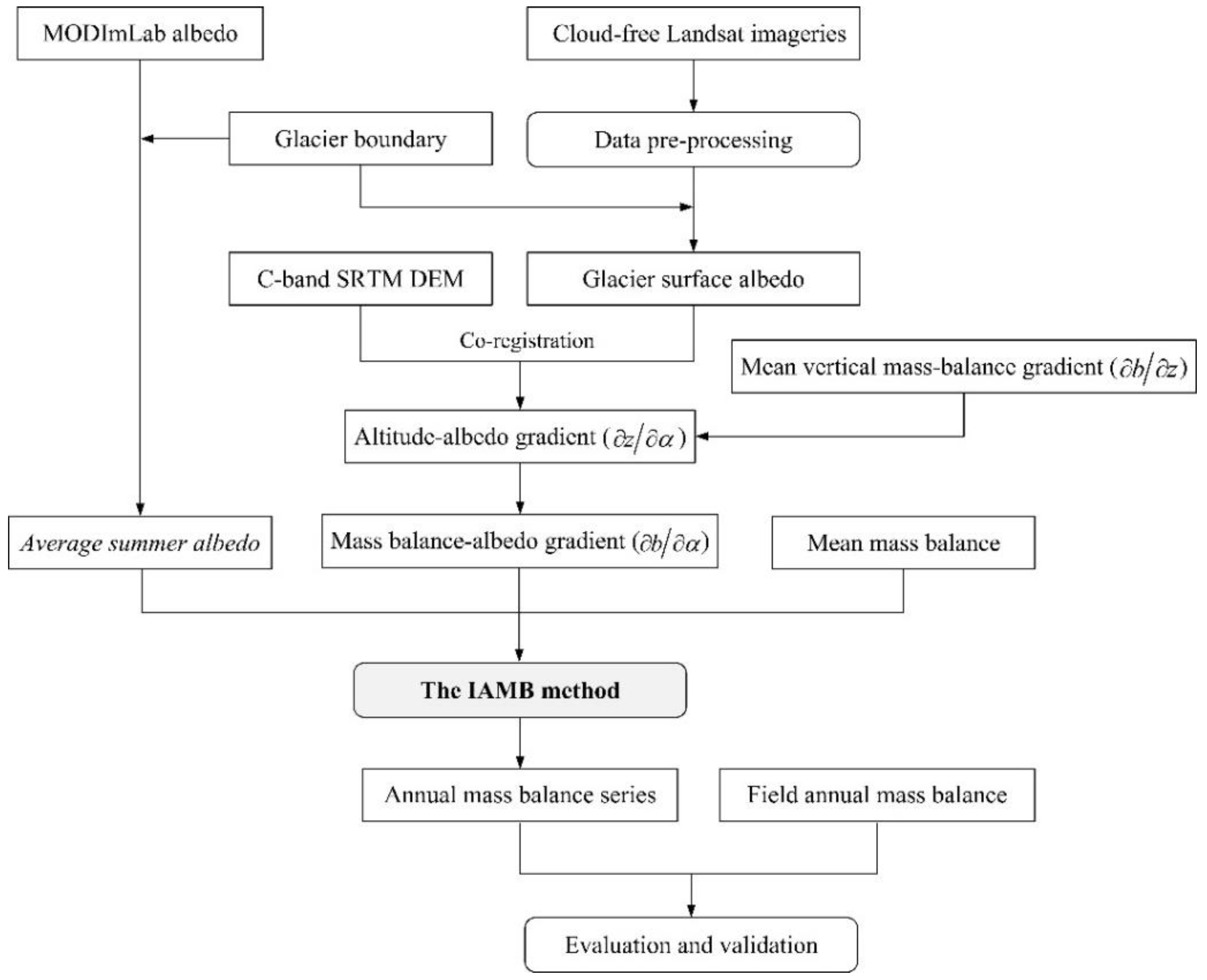
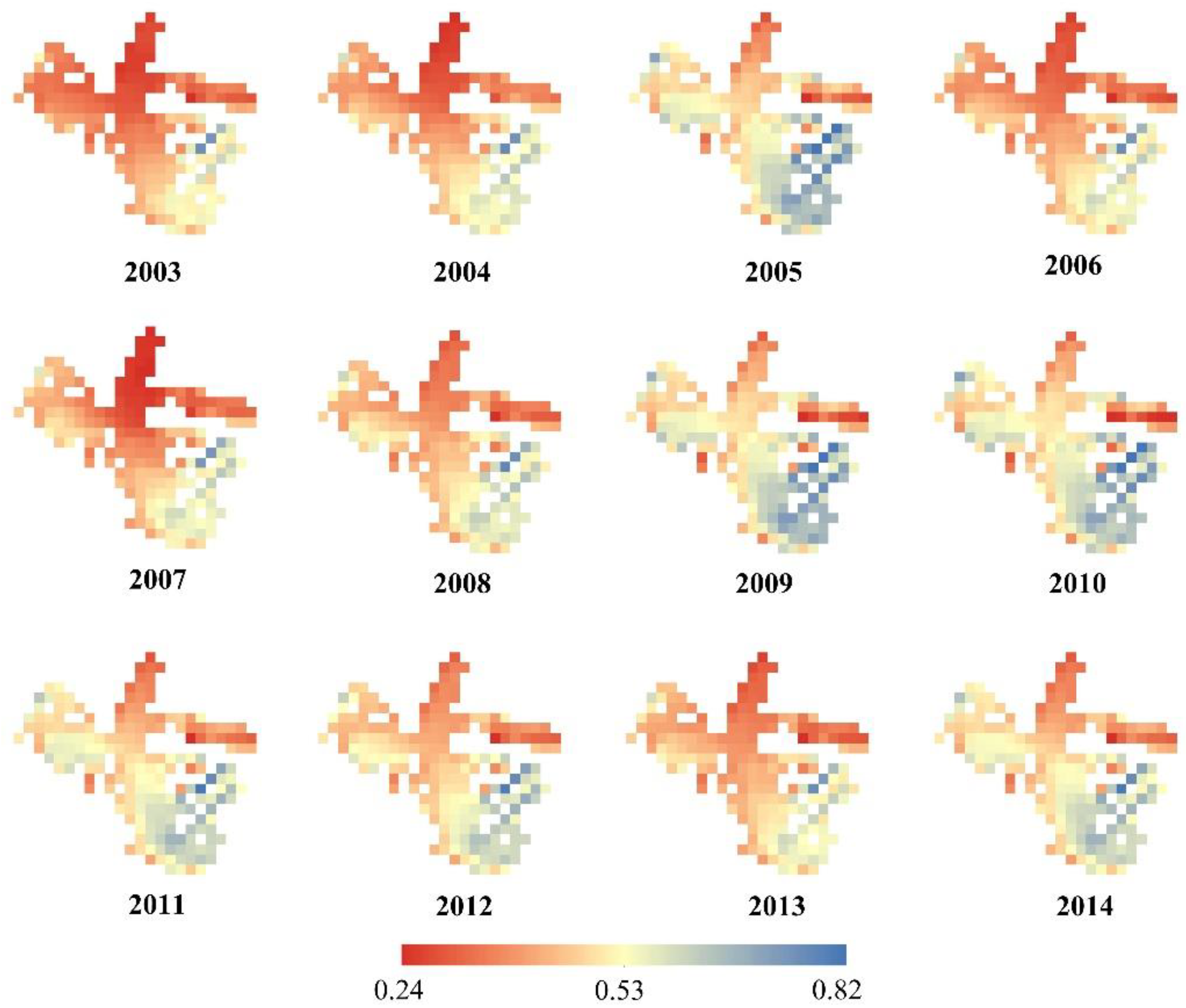
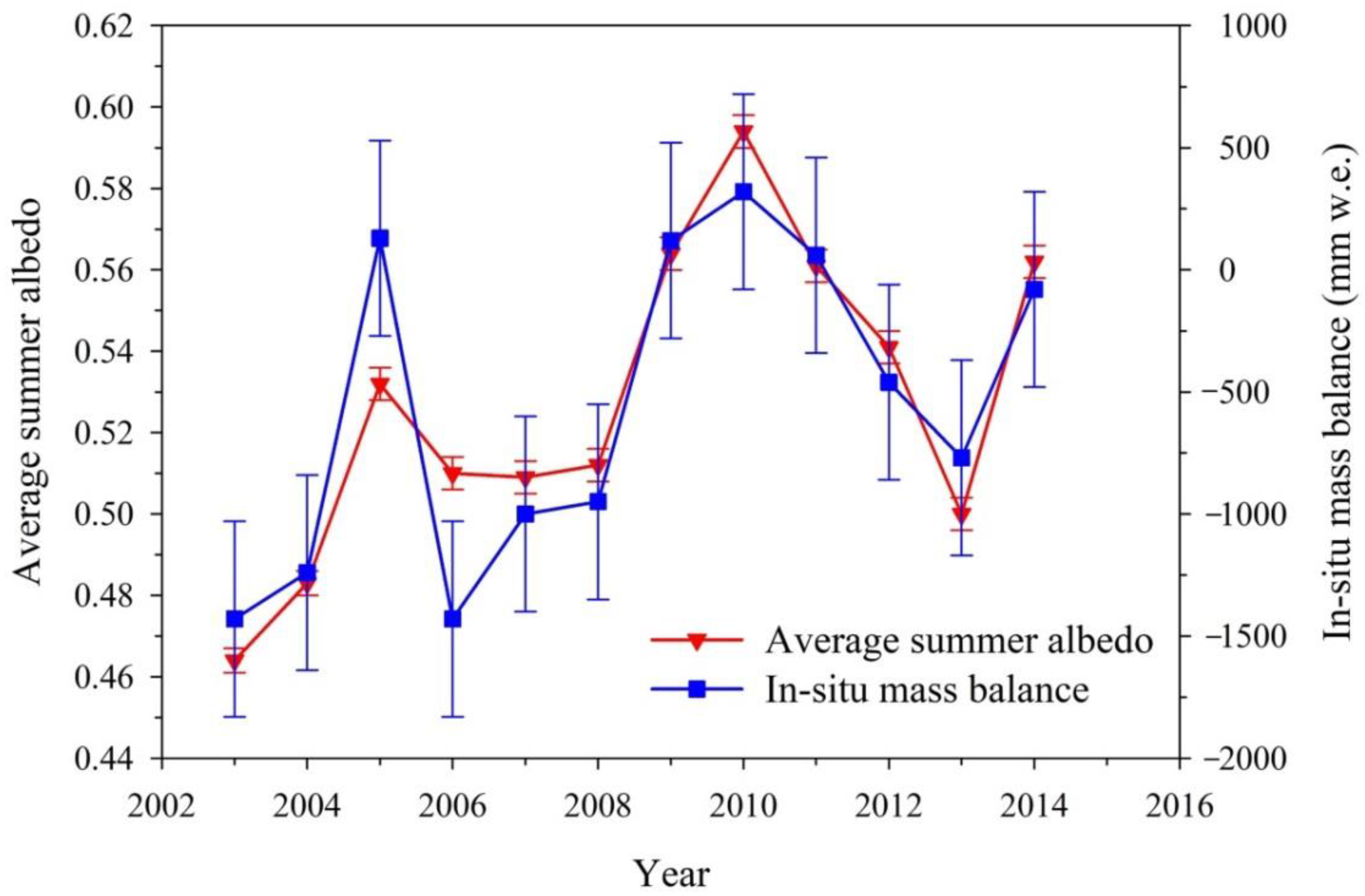

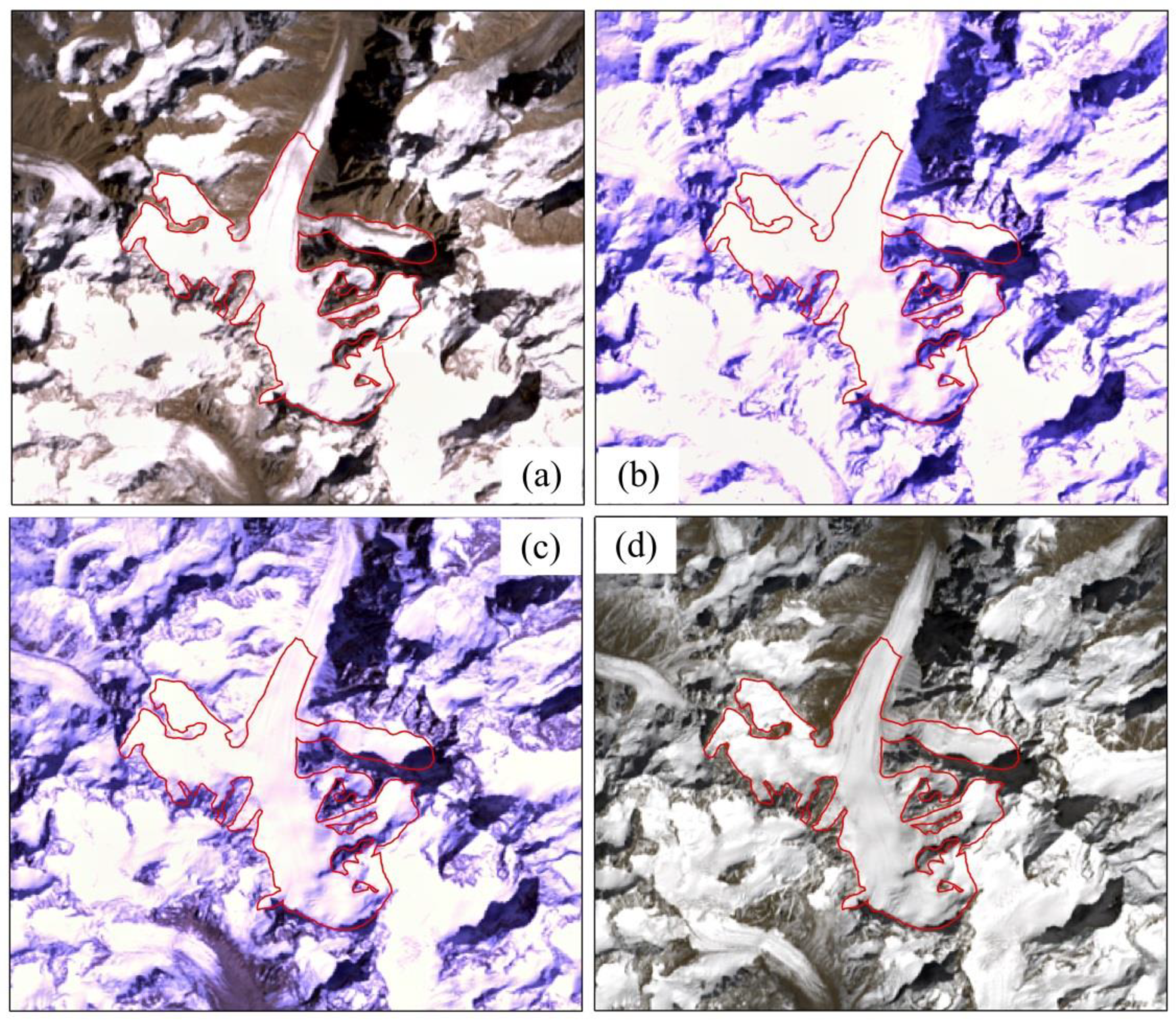
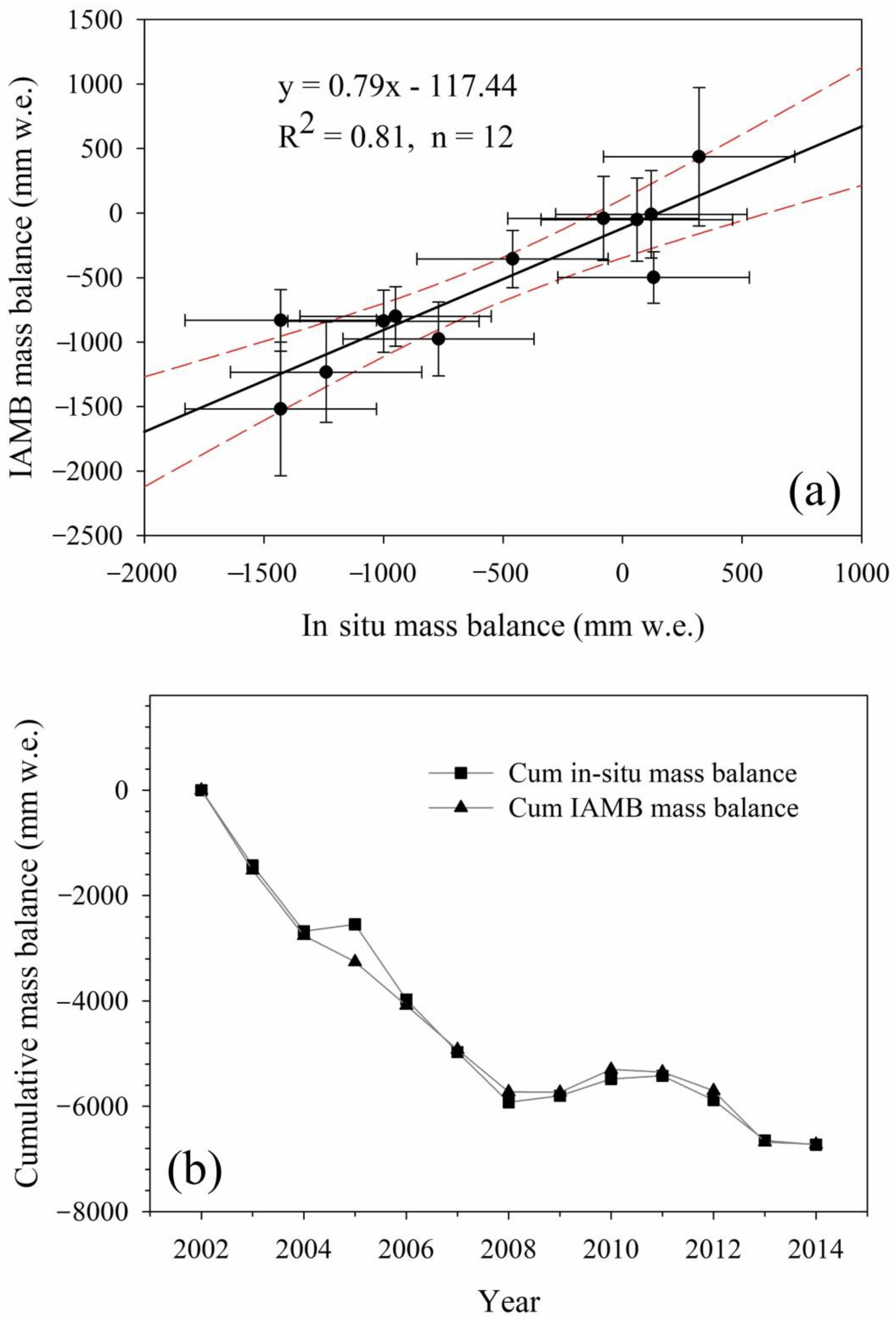


| Satellite | Sensor | Imagery Date (YYYY-MM-DD) | Sun Elevation/° |
|---|---|---|---|
| Landsat-7 | ETM+ | 2000-09-29 | 49.94 |
| Landsat-7 | ETM+ | 2001-06-28 | 66.06 |
| Landsat-5 | TM | 2001-09-24 | 50.07 |
| Landsat-5 | TM | 2008-06-23 | 65.93 |
| Landsat-5 | TM | 2008-09-27 | 49.75 |
| Landsat-5 | TM | 2009-09-30 | 49.64 |
| Landsat-5 | TM | 2010-07-15 | 64.95 |
| Landsat-8 | OLI | 2013-09-25 | 52.59 |
| Landsat-8 | OLI | 2014-08-11 | 63.27 |
| Landsat-8 | OLI | 2014-09-28 | 51.54 |
| Landsat-8 | OLI | 2015-07-29 | 65.20 |
| Landsat-8 | OLI | 2015-08-30 | 59.50 |
| Landsat-8 | OLI | 2015-09-15 | 55.42 |
| Landsat-8 | OLI | 2016-08-16 | 62.31 |
| Landsat-8 | OLI | 2017-09-04 | 58.22 |
| Landsat-8 | OLI | 2017-09-20 | 53.87 |
| Date | Correlation Coefficient (R) | |
|---|---|---|
| 2001-06-28 | 12.60 | 0.995 |
| 2001-09-24 | 40.20 | 0.987 |
| 2008-06-23 | 28.76 | 0.963 |
| 2010-07-15 | 11.90 | 0.975 |
| 2014-08-11 | 14.83 | 0.991 |
| 2014-09-28 | 17.29 | 0.990 |
| 2015-07-29 | 17.53 | 0.977 |
| 2015-08-30 | 23.41 | 0.985 |
| 2015-09-15 | 23.57 | 0.985 |
| 2016-08-16 | 53.75 | 0.967 |
| 2017-09-04 | 12.26 | 0.997 |
| 2017-09-20 | 18.52 | 0.990 |
| Mean | 22.88 | |
| Standard deviation | 12.69 |
Disclaimer/Publisher’s Note: The statements, opinions and data contained in all publications are solely those of the individual author(s) and contributor(s) and not of MDPI and/or the editor(s). MDPI and/or the editor(s) disclaim responsibility for any injury to people or property resulting from any ideas, methods, instructions or products referred to in the content. |
© 2022 by the authors. Licensee MDPI, Basel, Switzerland. This article is an open access article distributed under the terms and conditions of the Creative Commons Attribution (CC BY) license (https://creativecommons.org/licenses/by/4.0/).
Share and Cite
Zhang, Z.; Jiang, L.; Sun, Y.; Sirguey, P.; Dumont, M.; Liu, L.; Gao, N.; Gao, S. Reconstruction of Annual Glacier Mass Balance from Remote Sensing-Derived Average Glacier-Wide Albedo. Remote Sens. 2023, 15, 31. https://doi.org/10.3390/rs15010031
Zhang Z, Jiang L, Sun Y, Sirguey P, Dumont M, Liu L, Gao N, Gao S. Reconstruction of Annual Glacier Mass Balance from Remote Sensing-Derived Average Glacier-Wide Albedo. Remote Sensing. 2023; 15(1):31. https://doi.org/10.3390/rs15010031
Chicago/Turabian StyleZhang, Zhimin, Liming Jiang, Yafei Sun, Pascal Sirguey, Marie Dumont, Lin Liu, Ning Gao, and Songfeng Gao. 2023. "Reconstruction of Annual Glacier Mass Balance from Remote Sensing-Derived Average Glacier-Wide Albedo" Remote Sensing 15, no. 1: 31. https://doi.org/10.3390/rs15010031
APA StyleZhang, Z., Jiang, L., Sun, Y., Sirguey, P., Dumont, M., Liu, L., Gao, N., & Gao, S. (2023). Reconstruction of Annual Glacier Mass Balance from Remote Sensing-Derived Average Glacier-Wide Albedo. Remote Sensing, 15(1), 31. https://doi.org/10.3390/rs15010031






